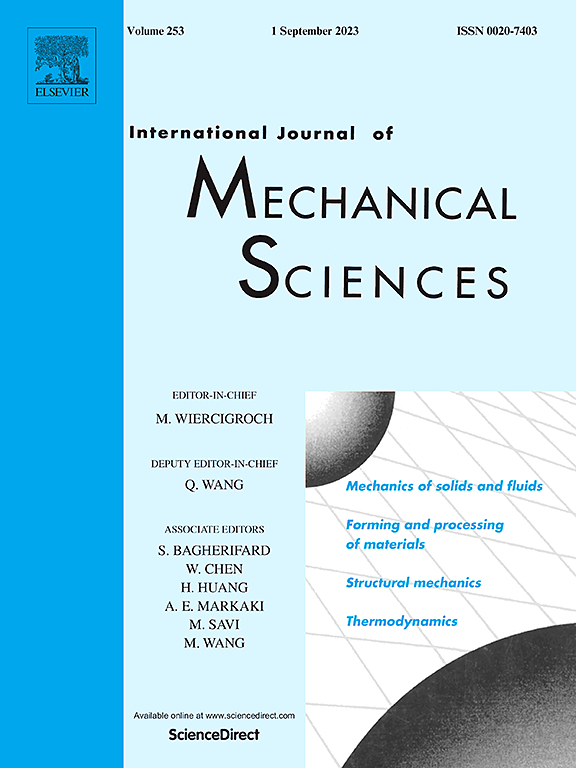Atomistic insights into tensile damage of functionally Graded Al-SiC composites
IF 7.1
1区 工程技术
Q1 ENGINEERING, MECHANICAL
International Journal of Mechanical Sciences
Pub Date : 2025-01-27
DOI:10.1016/j.ijmecsci.2025.110012
引用次数: 0
Abstract
The tensile behavior and damage mechanisms of functionally graded (FG) Al-SiC composites are systematically investigated using molecular dynamics (MD) simulations. A comprehensive set of large-scale MD simulations is conducted on FG composites composed of three layers reinforced with different volume fractions of randomly distributed three-dimensional SiC particles. This work introduces a novel approach by modeling the reinforcement ceramic as three-dimensional particles, thereby more accurately representing the FG composite microstructure. Predictions of the model for Young's moduli of composites align with experimental data from the literature. The yield and ultimate tensile strength are overestimated due to the high applied strain rates and idealized crystal structures used in the simulations, which lack common defects such as vacancies and dislocations. The model is utilized to study the influence of reinforcement particle shape, size, orientation, and distribution on the tensile and damage behavior of composites. The FG composites reinforced with cubic particles demonstrate lower yield and tensile strength than those with spherical particles, primarily due to the high-stress concentrations around the corners of the cubic reinforcements. Reducing the size of SiC particles enhances the elastic modulus, yield, and tensile strength of the FG composites. It is shown that the stiffness of the FG composites reinforced with rectangular prisms can be effectively tailored by changing the orientation of the reinforcements. When SiC rectangular prisms are aligned along the tensile direction, the resulting FG composites exhibit higher yield and tensile strength. This work offers fundamental atomistic insights that help design FG composites with better mechanical performance.求助全文
约1分钟内获得全文
求助全文
来源期刊

International Journal of Mechanical Sciences
工程技术-工程:机械
CiteScore
12.80
自引率
17.80%
发文量
769
审稿时长
19 days
期刊介绍:
The International Journal of Mechanical Sciences (IJMS) serves as a global platform for the publication and dissemination of original research that contributes to a deeper scientific understanding of the fundamental disciplines within mechanical, civil, and material engineering.
The primary focus of IJMS is to showcase innovative and ground-breaking work that utilizes analytical and computational modeling techniques, such as Finite Element Method (FEM), Boundary Element Method (BEM), and mesh-free methods, among others. These modeling methods are applied to diverse fields including rigid-body mechanics (e.g., dynamics, vibration, stability), structural mechanics, metal forming, advanced materials (e.g., metals, composites, cellular, smart) behavior and applications, impact mechanics, strain localization, and other nonlinear effects (e.g., large deflections, plasticity, fracture).
Additionally, IJMS covers the realms of fluid mechanics (both external and internal flows), tribology, thermodynamics, and materials processing. These subjects collectively form the core of the journal's content.
In summary, IJMS provides a prestigious platform for researchers to present their original contributions, shedding light on analytical and computational modeling methods in various areas of mechanical engineering, as well as exploring the behavior and application of advanced materials, fluid mechanics, thermodynamics, and materials processing.
 求助内容:
求助内容: 应助结果提醒方式:
应助结果提醒方式:


